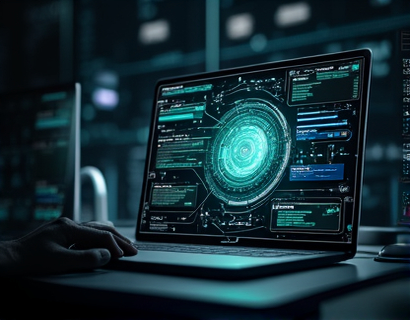Revolutionizing Productivity and App Accessibility: The Synergy of AI and Cryptocurrency
The intersection of artificial intelligence and cryptocurrency is giving birth to a new era of digital solutions that promise to revolutionize productivity and app accessibility. This fusion of technologies is not just a trend but a transformative shift that is redefining how we interact with digital tools and manage our daily tasks. For tech enthusiasts and early adopters, this convergence offers a glimpse into a future where efficiency and innovation go hand in hand.
The integration of AI and cryptocurrency is creating next-generation digital solutions that enhance productivity in unprecedented ways. These solutions leverage the strengths of both technologies: AI's ability to process and analyze vast amounts of data, and cryptocurrency's decentralized and secure nature. Together, they are unlocking new possibilities for task management, app accessibility, and overall digital efficiency.
Enhancing Task Management with AI-Powered Tools
One of the most significant impacts of AI in digital solutions is in the realm of task management. Traditional task management apps often struggle with scalability and personalization. AI-driven tools, however, can adapt to individual user preferences and workflows, providing a more tailored and efficient experience. These tools use machine learning algorithms to predict user needs, automate repetitive tasks, and optimize workflows.
For instance, AI can analyze a user's past behavior to suggest the best times to tackle certain tasks, automatically prioritize tasks based on urgency and importance, and even delegate tasks to team members if working in a collaborative environment. This level of personalization ensures that users can focus on high-value activities while mundane tasks are handled seamlessly in the background.
Decentralized App Accessibility Through Blockchain
Cryptocurrency and blockchain technology are playing a pivotal role in enhancing app accessibility. By leveraging blockchain, apps can offer decentralized access, eliminating the need for centralized servers and reducing the risk of single points of failure. This not only improves reliability but also enhances user privacy and security.
Decentralized apps (dApps) built on blockchain platforms can be accessed from anywhere in the world, without the need for intermediaries. This opens up a global market for users, ensuring that innovative digital solutions are accessible to a broader audience. Moreover, blockchain's transparent and immutable ledger provides a trustworthy environment for transactions and data storage, further boosting user confidence.
Smart Contracts for Automated Task Execution
Smart contracts, self-executing contracts with the terms directly written into code, are another powerful tool emerging from the AI and cryptocurrency fusion. In the context of productivity and app accessibility, smart contracts can automate complex workflows by executing tasks based on predefined conditions. For example, a smart contract can automatically release payment to a freelancer once the delivered work meets the agreed-upon quality standards.
This automation reduces the need for manual oversight and intermediaries, speeding up processes and reducing costs. For businesses and individuals alike, smart contracts offer a streamlined and efficient way to manage contracts, payments, and task executions, all while ensuring transparency and accountability.
Enhancing User Experience with AI-Driven Interfaces
The user interface (UI) of digital tools is crucial for a seamless user experience. AI is transforming UIs by making them more intuitive, responsive, and user-friendly. AI-powered UIs can adapt to user preferences and behaviors, providing a personalized experience that evolves over time. For instance, AI can analyze user interactions to optimize the layout, suggest frequently used features, and even predict user actions to pre-load relevant content.
Moreover, AI-driven natural language processing (NLP) enables more natural and efficient communication between users and apps. Voice assistants and chatbots powered by AI can understand and respond to user queries in a more human-like manner, making digital tools more accessible and user-friendly. This is particularly beneficial for users who may have difficulty navigating traditional UI interfaces.
Security and Privacy in AI and Crypto Solutions
Security and privacy are paramount in the digital age, and the combination of AI and cryptocurrency addresses these concerns effectively. Blockchain's inherent security features, such as cryptographic hashing and decentralized consensus mechanisms, ensure that data is secure and tamper-proof. AI enhances this by providing advanced threat detection and response systems.
AI algorithms can monitor network activity in real-time, identifying and mitigating potential security threats before they become problematic. Additionally, AI can help in compliance with data protection regulations by ensuring that user data is handled and stored securely. This dual approach of AI and cryptocurrency creates a robust framework for protecting user information and maintaining trust.
Case Studies: Real-World Applications
Several real-world applications demonstrate the potential of AI and cryptocurrency in enhancing productivity and app accessibility. For example, a project management platform that uses AI to optimize task assignments and blockchain for secure contract management has seen significant improvements in team efficiency and project completion rates. Users report reduced overhead and a more streamlined workflow, allowing them to focus on core business activities.
Another example is a decentralized marketplace for freelance services, where smart contracts ensure fair payment and transparent evaluations. This platform has attracted a global user base, breaking geographical barriers and providing access to a wider pool of talent. The use of AI in matching clients with the most suitable freelancers further enhances the platform's effectiveness.
Challenges and Future Prospects
Despite the numerous benefits, the integration of AI and cryptocurrency in digital solutions is not without challenges. One of the primary hurdles is the technical complexity involved in developing and maintaining these systems. Developers need a deep understanding of both AI and blockchain technologies to create robust and scalable solutions.
Another challenge is the regulatory landscape. As AI and cryptocurrency continue to evolve, regulatory frameworks are still catching up. Ensuring compliance while innovating is a delicate balance that requires ongoing attention and collaboration between developers, policymakers, and industry stakeholders.
Looking ahead, the future of AI and cryptocurrency in digital solutions is promising. As technology advances and adoption increases, we can expect more sophisticated and user-friendly tools that further enhance productivity and accessibility. The convergence of these technologies will continue to drive innovation, opening new avenues for growth and efficiency in various industries.
For tech enthusiasts and early adopters, embracing this fusion of AI and cryptocurrency offers exciting opportunities. By staying informed and experimenting with these cutting-edge solutions, they can stay ahead of the curve and contribute to shaping the future of digital tools.










































